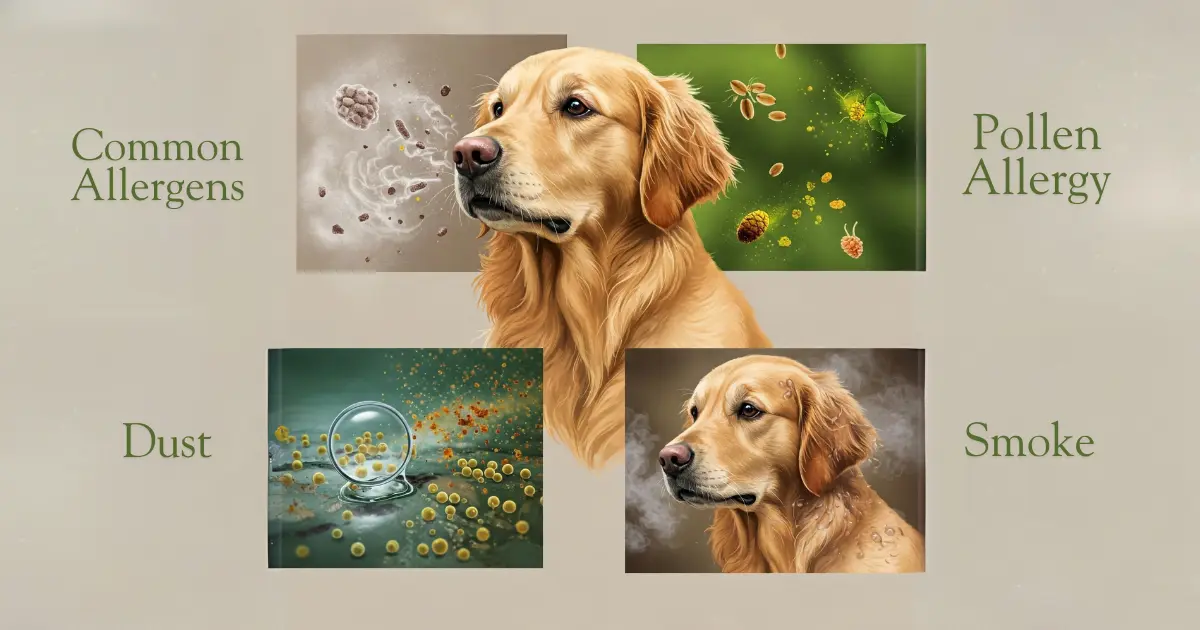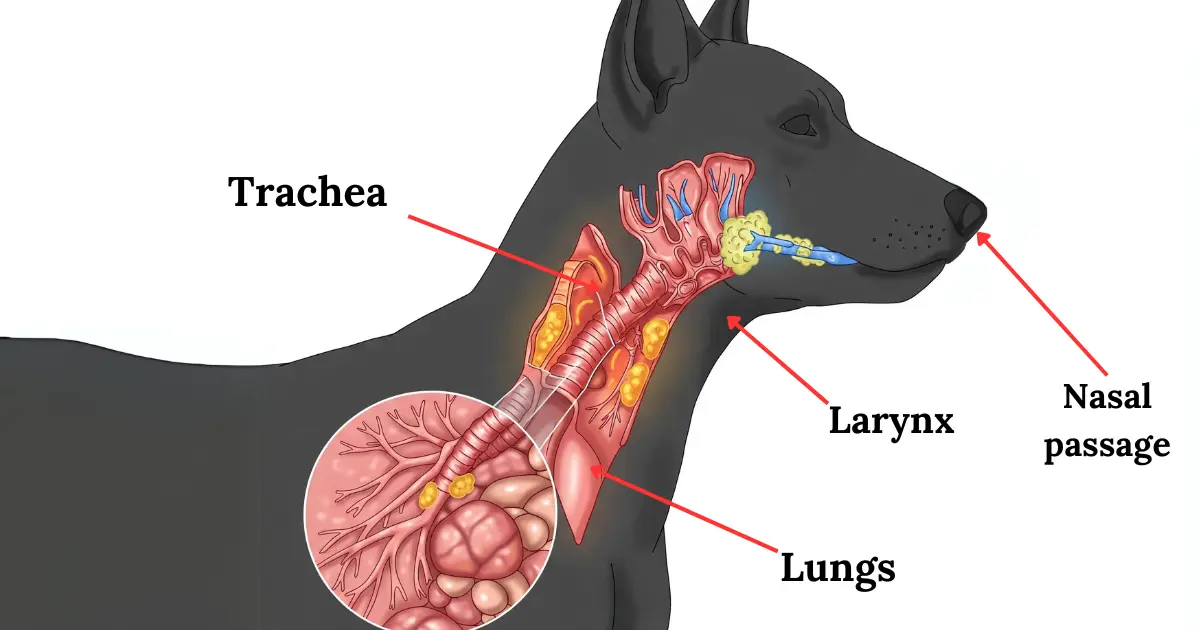Why Is My Dog Making a Wheezing Sound?
Published: 7 Feb 2025
You’re not alone if you’ve noticed your dog making a strange wheezing sound. It can be worrying to hear your furry friend struggle to breathe, even briefly. Wheezing is often a sign that something’s affecting your dog’s respiratory system, but don’t panic! Many possible causes, some harmless, while others need more attention.

In this guide, we’ll walk you through some of the most common reasons dogs wheeze and how to manage it. Don’t worry—we’ll give you practical tips to help keep your dog happy and healthy.
Table of Contents
What Is Wheezing?
Wheezing is a high-pitched noise your dog makes when breathing, typically when it exhales. It’s different from coughing, which usually involves more force and might sound more like a hacking noise. Wheezing can be mild or more persistent and can occur after physical activity, during rest, or in response to something irritating your dog’s airways.
If your dog only wheezes occasionally, it might not be something to worry about. But it’s time to pay attention if it happens often or they seem distressed or uncomfortable.

Why Is My Dog Wheezing?
There are several reasons why your dog might start wheezing. Let’s discuss the most common causes and what you can do about them.
1. Allergies: Could Pollen Be the Culprit?
Just like us, dogs can have allergies that affect their respiratory system. Dust, pollen, mold, and certain food ingredients can irritate your dog’s airways, leading to wheezing or sneezing. If you notice your dog wheezing more during certain times of the year—like in the spring or fall—seasonal allergies might be the cause.
Tip: Reduce allergens in your home by using an air purifier, vacuuming frequently, and washing your dog’s bedding. If you think food allergies might be a factor, talk to your vet about trying an elimination diet.
2. Respiratory Infections: Kennel Cough and Other Culprits
A respiratory infection is one of dogs’ most common causes of wheezing. Highly contagious kennel cough can lead to wheezing, coughing, and sneezing. This condition is typically mild but can be annoying and uncomfortable for your dog. If your dog has been around other dogs recently—perhaps at a dog park, daycare, or boarding facility—this could be the cause.
Tip: Kennel’s cough often clears up with rest and some veterinary care. If your dog’s wheezing is due to an infection, your vet may suggest a course of antibiotics or cough suppressants to help ease their symptoms.
3. Collapsing Trachea: A Small Dog Problem
If you have a small breed dog, like a Chihuahua, Yorkie, or Pomeranian, you may be familiar with a condition called collapsing trachea. This occurs when the cartilage in the windpipe weakens and causes it to collapse, making it harder for your dog to breathe normally. Dogs with this condition often make a honking sound, similar to wheezing.
Tip: If your small dog tends to wheeze after excitement or exercise, this could be the cause. While it’s not always life-threatening, collapsing trachea should be managed with care. Your vet might recommend weight management, unique collars, or even surgery in some cases.
4. Heart Disease: Older Dogs and Wheezing
Heart disease can sometimes cause wheezing in older dogs. When the heart isn’t functioning correctly, Fluid can accumulate in the lungs, making it harder for your dog to breathe and causing wheezing. This is more common in senior dogs, particularly those of breeds prone to heart issues, like Cavalier King Charles Spaniels or Dobermans.
Tip: If your dog is getting older and you’ve noticed signs like unusual tiredness, coughing, or breathing problems, it could be a sign of heart disease. It can be challenging to see your dog not feeling its best, but getting it checked by a vet is essential. Early diagnosis can make all the difference, and your vet can guide you on the best treatment, whether medication or adjusting their routine to help them feel better.
5. Obesity: Extra Pounds, Extra Pressure
If your dog carries extra weight, it can put added strain on its respiratory system, making it harder for it to breathe. Due to the added pressure on their lungs, Overweight dogs are at a high risk of developing health issues like collapsed trachea or respiratory problems.
Tip: If your dog is overweight, consider working with your vet on a healthy eating plan and regular exercise. Losing weight can reduce wheezing and improve your dog’s overall health.

When Should You Be Concerned?
While some wheezing is typical and nothing to worry about, it’s important to stay alert for signs that it could be something more serious. If your dog shows any of these symptoms, it’s a good idea to reach out to your vet for peace of mind and the best care.
- Breathing in Difficulty: If your dog is having difficulty breathing or breathing heavily, it’s a sign that it may need immediate attention.
- Blue or purple gums indicate that your dog isn’t getting enough oxygen and needs to be seen by a vet as soon as possible.
- Persistent or worsening wheezing: If it lasts over a few days or worsens over time, it’s worth seeking veterinary care.
- Fatigue and weakness: If your dog is lethargic, loses interest in play, or seems more tired than usual, it could be a sign of a more serious issue.
Tip: Trust your gut—if you’re unsure about your dog’s health, it’s always a good idea to contact your vet for advice. It’s better to be safe than sorry!
What Can You Do to Help Your Wheezing Dog?
If your dog’s wheezing is mild and not accompanied by other severe symptoms, here are a few things you can do to help:
1. Track the Wheezing Patterns
Keep track of when your dog is wheezing. Does it happen after they play or run around? Or do they seem to wheeze more when exposed to specific allergens, like dust or pollen? Noticing patterns can help you and your vet figure out the cause. Dogs also experience involuntary movements when resting, and you might wonder why dogs shake in their sleep.
Tip: Try using a note app on your phone to jot down when your dog wheezes and any other behaviors you notice. This will help your vet better understand your dog’s symptoms.
2. Keep Your Dog Calm and Relaxed
Sometimes, wheezing can be triggered by excitement or stress. If your dog tends to wheeze when it’s anxious or worked up, try to create a more calming environment. Using calming music or a cozy space can help them relax.
Tip: Try an anxiety wrap or calming collar to help soothe your dog during stressful moments like thunderstorms or car rides.

3. When to See the Vet for Persistent Wheezing
If your dog’s wheezing doesn’t improve or worsen, it must be taken to the vet. I completely understand how tough it is to watch them struggle. The vet can run tests, like X-rays, to figure out what’s happening. Once they know what’s happening, they can recommend the proper treatment to help your dog feel better and return to its happy self.
Tip:If your dog’s symptoms change or worsen, don’t wait too long to get them checked by a vet. It can be challenging, but your vet can figure out what’s happening and help your dog feel better again.
How to Prevent Wheezing in Dogs
While not every case of wheezing can be stopped, there are a few steps you can take to reduce the risk:
1. Maintain a Healthy Weight
Maintaining a healthy weight for your dog helps ease the strain on their lungs and can help prevent obesity-related respiratory issues. Regular exercise, portion control, and following essential dog care tips can help keep your pup in great shape.
Tip: Talk to your vet about portion sizes and ideal exercise routines for your dog’s breed and age.
2. Reduce Exposure to Allergens
To help ease your dog’s wheezing from allergies, try to limit the allergens in your home. Using an air purifier, washing their bedding regularly, and Closing the windows during pollen season can make a noticeable difference. These small efforts can improve your dog’s comfort, especially if they’re sensitive to dust or pollen.
Tip: After your dog enters the home, try wiping off its paws and coat to remove any allergens or dust it might have picked up outside; small steps can significantly reduce its exposure to irritants.
3. Regular Vet Visits
Routine check-ups are vital to keeping your dog healthy and catching any root cuases before they become serious. Your vet will monitor your dog’s heart, lungs, and general well-being.
Tip: Book annual check-ups with your vet, and always feel free to ask about your dog’s breathing or overall health. It’s much better to catch things early and get the answers you need to keep your pup happiest and healthiest.
Conclusion
Wheezing in dogs can be unsettling, but it’s not always a cause for alarm. If you’ve noticed your dog wheezing or acting a little off, understanding what’s causing it can make all the difference. Whether it’s managing their allergies, helping them stay at a healthy weight, or knowing when it’s time for a vet visit, being in tune with their needs will go a long way in ensuring they have a happy, healthy life by your side.
Keeping your dog healthy requires attention to their breathing, diet, and overall wellness For expert guidance on dog health and care, visit the American Kennel Club (AKC) Dog Health Guide for trusted resources and expert tips.
FAQ
1. What does it mean when a dog wheezes?
Wheezing occurs when airways are partially blocked due to allergies, infections, or structural issues. It can be temporary or indicate an underlying health condition.
2. Can dogs develop wheezing suddenly?
Yes, sudden wheezing can result from allergens, foreign objects, or infections. If it persists or worsens, a medical evaluation is recommended.
3. Is occasional wheezing in dogs regular?
Mild, infrequent wheezing is common and may not be a concern. A vet should examine frequent episodes or signs of distress.
4. What household factors trigger dog wheezing?
Dust, strong scents, smoke, and mold can irritate the airways. Keeping indoor air clean reduces exposure to these triggers.
5. Do some dog breeds wheeze more than others?
Flat-faced breeds and small dogs with weak tracheas are more prone to wheezing. Proper care and weight management help reduce risks.
6. Can diet influence wheezing in dogs?
Certain ingredients may cause allergic reactions, leading to respiratory issues. If food intolerance is suspected, a diet adjustment may help.
7. How does temperature affect a dog’s breathing?
Extreme heat or cold can irritate airways and cause breathing difficulties. Keeping dogs in a moderate climate helps prevent stress on their respiratory system.
8. Can medication stop dog wheezing?
Treatment depends on the cause—antihistamines, steroids, or antibiotics may be prescribed. A vet’s diagnosis is necessary before giving any medication.
9. Should I be concerned if my dog only wheezes after exercise?
Exercise-induced wheezing may indicate airway sensitivity or an underlying condition. Monitoring intensity and duration helps manage symptoms.
10. How can I reduce my dog’s risk of wheezing?
Keeping the air clean, maintaining a healthy weight, and scheduling regular vet visits help minimize breathing issues. Identifying and managing triggers reduces recurrence.

- Be Respectful
- Stay Relevant
- Stay Positive
- True Feedback
- Encourage Discussion
- Avoid Spamming
- No Fake News
- Don't Copy-Paste
- No Personal Attacks



- Be Respectful
- Stay Relevant
- Stay Positive
- True Feedback
- Encourage Discussion
- Avoid Spamming
- No Fake News
- Don't Copy-Paste
- No Personal Attacks





